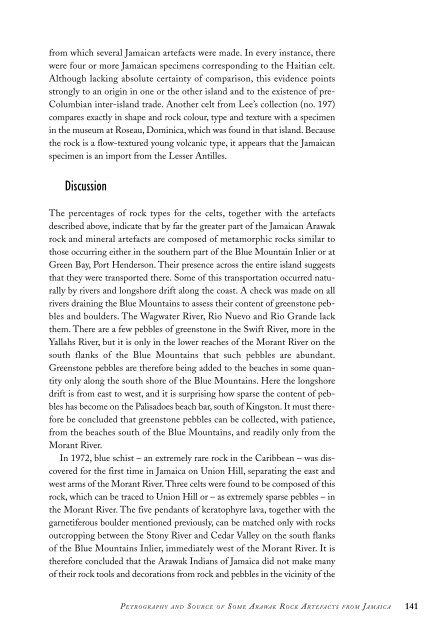The Earliest Inhabitants: The Dynamics of the Jamaican Taino
by Lesley-Gail Atkinson
by Lesley-Gail Atkinson
Create successful ePaper yourself
Turn your PDF publications into a flip-book with our unique Google optimized e-Paper software.
from which several <strong>Jamaican</strong> artefacts were made. In every instance, <strong>the</strong>re<br />
were four or more <strong>Jamaican</strong> specimens corresponding to <strong>the</strong> Haitian celt.<br />
Although lacking absolute certainty <strong>of</strong> comparison, this evidence points<br />
strongly to an origin in one or <strong>the</strong> o<strong>the</strong>r island and to <strong>the</strong> existence <strong>of</strong> pre-<br />
Columbian inter-island trade. Ano<strong>the</strong>r celt from Lee’s collection (no. 197)<br />
compares exactly in shape and rock colour, type and texture with a specimen<br />
in <strong>the</strong> museum at Roseau, Dominica, which was found in that island. Because<br />
<strong>the</strong> rock is a flow-textured young volcanic type, it appears that <strong>the</strong> <strong>Jamaican</strong><br />
specimen is an import from <strong>the</strong> Lesser Antilles.<br />
Discussion<br />
<strong>The</strong> percentages <strong>of</strong> rock types for <strong>the</strong> celts, toge<strong>the</strong>r with <strong>the</strong> artefacts<br />
described above, indicate that by far <strong>the</strong> greater part <strong>of</strong> <strong>the</strong> <strong>Jamaican</strong> Arawak<br />
rock and mineral artefacts are composed <strong>of</strong> metamorphic rocks similar to<br />
those occurring ei<strong>the</strong>r in <strong>the</strong> sou<strong>the</strong>rn part <strong>of</strong> <strong>the</strong> Blue Mountain Inlier or at<br />
Green Bay, Port Henderson. <strong>The</strong>ir presence across <strong>the</strong> entire island suggests<br />
that <strong>the</strong>y were transported <strong>the</strong>re. Some <strong>of</strong> this transportation occurred naturally<br />
by rivers and longshore drift along <strong>the</strong> coast. A check was made on all<br />
rivers draining <strong>the</strong> Blue Mountains to assess <strong>the</strong>ir content <strong>of</strong> greenstone pebbles<br />
and boulders. <strong>The</strong> Wagwater River, Rio Nuevo and Rio Grande lack<br />
<strong>the</strong>m. <strong>The</strong>re are a few pebbles <strong>of</strong> greenstone in <strong>the</strong> Swift River, more in <strong>the</strong><br />
Yallahs River, but it is only in <strong>the</strong> lower reaches <strong>of</strong> <strong>the</strong> Morant River on <strong>the</strong><br />
south flanks <strong>of</strong> <strong>the</strong> Blue Mountains that such pebbles are abundant.<br />
Greenstone pebbles are <strong>the</strong>refore being added to <strong>the</strong> beaches in some quantity<br />
only along <strong>the</strong> south shore <strong>of</strong> <strong>the</strong> Blue Mountains. Here <strong>the</strong> longshore<br />
drift is from east to west, and it is surprising how sparse <strong>the</strong> content <strong>of</strong> pebbles<br />
has become on <strong>the</strong> Palisadoes beach bar, south <strong>of</strong> Kingston. It must <strong>the</strong>refore<br />
be concluded that greenstone pebbles can be collected, with patience,<br />
from <strong>the</strong> beaches south <strong>of</strong> <strong>the</strong> Blue Mountains, and readily only from <strong>the</strong><br />
Morant River.<br />
In 1972, blue schist – an extremely rare rock in <strong>the</strong> Caribbean – was discovered<br />
for <strong>the</strong> first time in Jamaica on Union Hill, separating <strong>the</strong> east and<br />
west arms <strong>of</strong> <strong>the</strong> Morant River. Three celts were found to be composed <strong>of</strong> this<br />
rock, which can be traced to Union Hill or – as extremely sparse pebbles – in<br />
<strong>the</strong> Morant River. <strong>The</strong> five pendants <strong>of</strong> keratophyre lava, toge<strong>the</strong>r with <strong>the</strong><br />
garnetiferous boulder mentioned previously, can be matched only with rocks<br />
outcropping between <strong>the</strong> Stony River and Cedar Valley on <strong>the</strong> south flanks<br />
<strong>of</strong> <strong>the</strong> Blue Mountains Inlier, immediately west <strong>of</strong> <strong>the</strong> Morant River. It is<br />
<strong>the</strong>refore concluded that <strong>the</strong> Arawak Indians <strong>of</strong> Jamaica did not make many<br />
<strong>of</strong> <strong>the</strong>ir rock tools and decorations from rock and pebbles in <strong>the</strong> vicinity <strong>of</strong> <strong>the</strong><br />
P ETROGRAPHY AND S OURCE OF S OME A RAWAK R OCK A RTEFACTS FROM J AMAICA<br />
141


















